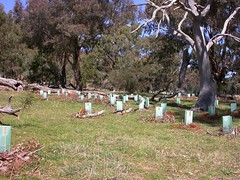The below FoMM 2010/2011 Report has been published in Scribbly Gum, the annual journal of the ACT parkCare groups (pdf)
During the 2010/2011 financial year volunteers contributed over 4000 hours towards the enhancement of Mount Majura nature reserve (3380 hours per year in the past five financial years). On average, 11.5 volunteers attended our regular monthly working parties to control weeds, tackle erosion and care for planted seedlings. We held a number of large-scale events such as National Tree Day community and school plantings and FoMM members worked in their own time on various projects such as controlling Cootamundra wattle and St John’s Wort or restoring a 5 hectares stock camp. We conducted several sessions to collect seeds of ground cover plants, shrubs, She-oak and trees for future plantings. We hosted a workshop on the identification and management of grass weeds, updated and published the Mount Majura and Mount Ainslie flora list and wrote two submissions that addressed the “Draft ACT Pest Animal Management Strategy 2011-2021” and “Managing Rabbits in Canberra Nature Park”.
We organised expert guided walks with topics on trees and ecological communities, nocturnal life, ants and wildflowers. Jointly with our neighbour parkCare groups we cleaned bush land at Australian Clean-up Day and tackled woody weeds in the “Common”, a weed infested grassy woodland below the saddle between Mt Majura and Mt Ainslie which FoMM and the Mt Ainslie Weeders attend once a year at a joint working bee.
FoMM together with our neighbour ParkCare groups, the Mount Ainslie Weeders and the Watson Woodland Working Group received the ACT Landcare Award 2011 in the Urban Landcare category in recognition of our combined effort to engage the public in protecting and enhancing the natural environment at the doorstep of established suburbs. The three groups will represent the ACT at the Federal Landcare Award 2012.
In the 2010 edition of Scribbly Gum I presented two photographs of a cleared part of the Majura paddock, one of our project sites close to the Hackett reservoir. The first from October 2007 shows a purple sea of Paterson’s Curse and the second taken in October 2010 after 3 years of persistent weed control by volunteers shows no visible Paterson’s Curse. Recent monitoring in the paddock revealed two lonely Curses as well as a great reduction of the yellow weeds cohort of Cape weed, Hedge mustard, flatweed and fleabane, which we controlled in the past two years along with our target weeds Curse, St John’s Wort, horehound, and noxious grass weeds.
The pair of photographs presented in this Scribbly Gum edition shows the impact of volunteers on the horehound infested wooded part of the paddock. We hand-weeded seed producing horehound, spot-sprayed regrowth (2-3 applications of MCPA per annum), broadcasted seeds of local grass species and planted shrubs and groundcover such as Clustered Everlastings. Thanks to favourable weather condition, removal of weed competition, some direct seeding and reduction of grazing pressure (rabbits) the native grass cover improved during the past year, which in turn helps to suppress germination and new establishment of weeds.


Horehound infested timbered part of Majura paddock on 15 September 2009 (left) and the same site on 16 October 2011 (right). Volunteers hand weeded seed bearing horehound, spot sprayed horehound regrowth and other weeds, direct seeded native grass and planted a mixture of local shrub and ground cover species.
The restoration of the Majura paddock is one of the many success stories of FoMM and parkCare and the result of hard work in partnership with rangers and the wider community. An ongoing great concern, however, is the grazing pressure, which if not addressed by the land manager will render our weed control and revegetation efforts unsustainable (for example, we spend about 0.5 hours on average to protect a single seedling from damage by grazing).
We face challenges from encroaching development, vandalism (recently we noticed large-scale rock and log rolling most likely to collect wildlife), impact of increasing recreational activities, shortage of resources to manage this impact and it seems that recreation replaces conservation as the prime management objective of CNP in the thinking of some government agencies. It takes a fair amount of commitment and enthusiasm to overcome the struggles associated with these challenges.
The decision of the Parks and Conservation Service (PCS) administration to exclude parkCare from the initial consultation of the proposed Centenary Trail was in my view a breach of trust which robbed me of my enthusiasm. The result of this exclusive consultation is the Feasibility Report which suggests to exploit the natural environment of Canberra Nature Park for nature-based tourism and to use parkCare as the provider of free labour to maintain assets. Our rangers know that parkcaring takes a fair amount of motivation and volunteers work best in partnership. It is not the hard work that de-motivates me, but being ignored and not valued as partner.
I’d like to thank all FoMM volunteers for giving their time and the rangers of North District, the Molonglo Catchment Group, the North Canberra Community Council, the Hackett Community Association, the Hackett Neighbourhood Watch, Greening Australia, the Majura Mountain Scouts and the local Blue Gum School for continuous support and interest. I wish Nadia and Joel all the best in their new life; it was a great pleasure to work with you and I hope you will come back to the North District.
Waltraud Pix
Friends of Mt Majura Co-ordinator
admin@majura.org


